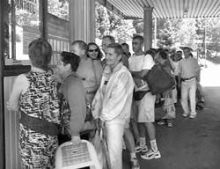There are 18,000 customs officers in Ukraine, including 1,200 in Transcarpathia. This region has 18 checkpoints on the borders of three neighboring countries - Hungary, Slovakia, and Rumania. It is also planned to open a checkpoint on the Polish border. This year, the Chop customs office, which has been updated to the most modern standards with the help of 3 million euros provided by the EU, is celebrating its 60th anniversary. The Uzhhorod customs office was set up 30 years ago to service all three checkpoints on the Ukraine-Slovak border. Naturally, close cooperation between the customs officers of Ukraine and Slovakia can speed up the border crossing procedure.
Recently Uzhhorod welcomed the customs officers of the Vesne Nemecke checkpoint, who played a soccer match with officers of the Uzhhorod checkpoint. The Ukrainians won 2 to 1. Chatting after the game, the officers noted that the problems that crop up between the two adjacent checkpoints often resemble the passing of a ball. For example, the Ukrainian side claims that their Slovak counterparts intentionally slow down the traffic, clearing no more than 5 to 7 cars an hour.
Drivers are undoubtedly the best arbiters in this dispute. Uzhhorod resident Natalka Kozak says: “In the last while it’s not been unusual to wait for 12 or even 24 hours. What’s the problem? There is an army of Slovak travelers, and the Slovak side is unable to quickly clear the cars and foot traffic. They’ve been granted a visa-free regime, so they walk across the border and back 5-6 times a day, while we have to stand here.”
Residents of cross-border Slovak villages make very peculiar use of the visa-free regime imposed by Ukraine on the citizens of EU member states. To avoid the torment of waiting in car lines, they just walk to Ukraine. After buying things next to the control barrier, they go back home. In a 24-hour period there are up to 500 such “pedestrians”. They are dealt with on a preferential basis, although the number of customs officers on both sides is still inadequate. In addition, our officers’ outdated computers often crash, and they have to make notes in the registers by hand. Incidentally, the Ukrainian-Hungarian Chop-Zagon checkpoint forbids crossing the border on foot from the Hungarian side: people can only use cars or motorcycles.
On the Ukrainian side, people standing in a long lineup go to the so-called green channel: this means they are checked on a selective basis. Interestingly, they very seldom try to smuggle cigarettes and vodka because if these items are found, the culprit may be banned from entering Slovakia for several years. The most profitable commodity is fuel in tanks. One can cash in well by selling it in Slovakia or Hungary.
Under the new regulations, a so-called single office was set up last May at the Uzhhorod checkpoint. This means that the customs officers assumed the functions of some other services. The acting checkpoint chief, Oleksandr Rego, thinks that this innovation has speeded up clearance by 10-12%. If they had more equipment and personnel, as they have been promised, there would be no problems whatsoever. As for truck drivers, they would like to see more radical changes. Truckers complain that they are very much constrained by having to wait for advance notices (a practice abolished long ago in Europe) from inland customs offices that are only open until 5 p.m., God knows why. As a result, sometimes they have to hang around the checkpoint for several days and nights.
Now that the Slovaks have received another ™1,500,000 installment, they have begun the second stage of reconstructing the infrastructure of the Vesne Nemecke checkpoint. Ukraine is trying to keep abreast. According to Valeriy Borysov, a department chief at the Uzhhorod customs office, European Commission representatives are quite actively working to carry out the Uzhhorod checkpoint reconstruction project. Work may start later this year. The EU is allocating ™3,000,000 for the first stage of this project and ™7,600,000 later.







